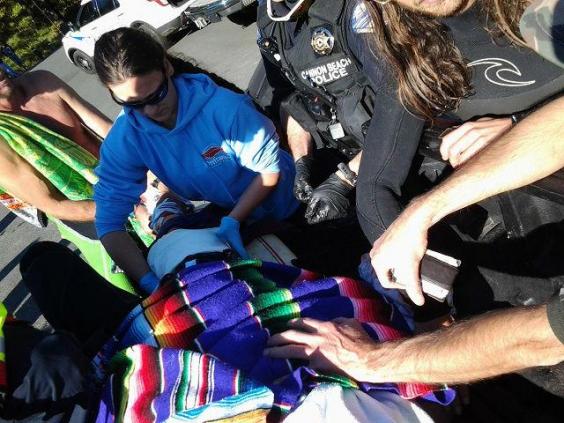JENNY Mulder should be dead. Instead, she owes her life to a “mechanical plunger” that pounded her chest for 57 minutes, keeping her heart beating — and her alive.
The 65-year-old went into cardiac arrest while in the emergency department at Royal Prince Alfred Hospital but luckily for her, the hospital was equipped with a LUCAS machine, which performs CPR at 100 pumps per minute.
The machine, which is also installed in six rapid response ambulances in the Sydney CBD, is part of a new clinical trial between St Vincent’s Hospital, RPA Hospital and NSW Ambulance.
Nurses Ashleigh Dolton (left) and Megan Moudawar inspect the Lucas 2 device.
“We have moved from resuscitating the alive to resuscitating the dead,” RPA Hospital Emergency Department acting director Dr James Edwards said.
“It’s the concept of people who (we) previously said ‘no, they have died, we can’t actually bring them back’, to now where we can bring them back.”
The LUCAS machine, combined with a second device called an extracorpor-eal membrane oxygenation (ECMO), have been hailed as the future of CPR and cardiology treatment.
The ECMO replaces heart and lung function for up to weeks at a time.
The combination of the two machines buys doctors crucial time to diagnose and treat the underlying cause of the cardiac arrest, and also gives the heart time to recover.
Art shows the Lucas function. Bottom left: Jenny Mulder thanks Brett Simpson.
Both hospitals had been using the technology for about 18 months before the clinical trial, with health officials now assessing how they would be of greater use in a co-ordin-ated approach.
Since February the devices have also been installed in six CBD ambulances.
Of the 30,000 Australians who suffer a sudden cardiac arrest each year fewer than 10 per cent survive, with 95 per cent of victims dying before they reach hospital.
The trial is expected to involve 25 patients over two years, and is modelled on a similar trial in Melbourne which increased survival rates for refractory cardiac arrests from 5 per cent to 50 per cent.
Paramedics and doctors will only use LUCAS on patients who are under 70 and have had some CPR performed before paramedics arrive.
The cardiac arrest also needs to have been no more than 60 minutes old, been witnessed, and been caused by a cardiac issue and not something else.
“It is a very aggressive and experimental approach to a very complicated problem,” RPA cardiologist Associate Professor Paul Forrest said.
Jenny Mulder catches up with paramedic Brett Simpson. Her heart stopped beating for 57 minutes before making a full recovery.
We think if we can demonstrate that there is a survival rate of between 40-50 per cent that’s a huge improvement on what is currently achievable. It is a trial but the preliminary results are very encouraging.”
Mrs Mulder was this week reunited with paramedic Brett Simpson, one of the four paramedics who arrived at her Glebe house after she suffered a heart attack in April.
After being taken to RPA, Mrs Mulder went into cardiac arrest. Mr Simpson began CPR and shortly after, the LUCAS machine was strapped on Mrs Mulder. It was then Mr Simpson witnessed something which is almost science fiction.
“Maybe four or five times we actually stopped everything because you were waking up and your arms were grabbing at the machine,” Mr Simpson told Mrs Mulder.
“Blood was going to the brain almost too well.
“We were like ‘crap, she’s waking up again’.”
Traditional CPR increases a patient’s blood flow to the point they are barely surviving. Mr Simpson said people should be unconscious during cardiac arrest because there is very little blood pressure.
“This LUCAS machine was actually giving you enough blood pressure — and it was perfusing your brain enough — that you are actually waking up when your heart was not beating,” Mr Simpson said
“That is how good these machines are.
The Ecmo Cardio Help machine pushes oxygenated blood through a patient’s body. It is used in conjunction with the Lucas plunger.
“The best CPR that you can muster only manages a blood pressure of about 40 or 50, which at that point is barely enough to be perfusing the brain or internal organs.
“For a person to come from no blood pressure, as Jenny had, to then become awake her blood pressure would have had to have been about 80 or 90, which is physically impossible with regular CPR.”
Mrs Mulder was then taken to the intensive care unit where she was placed on an ECMO machine for 24 hours. She left the hospital nine days later fully recovered.
Dr Forest said Mrs Mulder could not have been any closer to death.
“It is pretty dramatic in the sense that you’ve got people who would almost certainly die otherwise can be brought back. It was an absolutely spectacular result,” he said.
The LUCAS was conceived in 1991 by a Norwegian paramedic and has been in UK and European hospitals since 2006.
Mr Simpson said the LUCAS could be revolutionary for the ambulance service in NSW.
“We have had it ingrained in us from day one this is how you do cardiac arrest and CPR,” he said. “Now all of a sudden that is being flipped on its head with LUCAS. Quite often, out of hospital, we will run a cardiac arrest with four people and everyone has a role to play. Now in the same situation we have an extra person.”
Mrs Mulder said she had been ready for death, with the last thing she remembered seeing the bright lights of the defibrillators.
“I feel that life now is just another door that closes,” the mother-of-one said.
“Everything is OK when you leave. You take a lot of what you carry with you. You leave a lot behind and it is just a beautiful feeling.
“The fear of dying is not there any more. It is just another door that you pass through. I reached a point, when the ambulance came through, that I do not have any resources to know what to do now. I had to completely surrender so I just let go.
Jean-Paul Nicolazo, 69, at a family christening. He survived a cardiac arrest which lasted one hour thanks to paramedics and doctors at St Vincent’s Hospital and the new clinical trial.
“I don’t want to just thank the robot, but it performed miracles. The doctor said that years ago I would not have survived. So to have that facility is amazing. I feel lucky just to be alive.”
Her incredible recovery is not isolated.
Jean-Paul Nicolazo, 69, was dropping his two-year-old granddaughter at daycare in Centennial Park on April 5 when he had a cardiac arrest.
Three people, including his 37-year-old son Olivier, performed CPR on him before paramedics put him on the LUCAS machine.
The Parisian was in cardiac arrest for 60 minutes, but Dr David Roy and his team at St Vincent’s Hospital staff were able to bring him back to life. He has made a full recovery.
French tourist Eric Bruyer, 49, suffered a cardiac arrest at the Novotel in Darling Harbour. His son, Max, fetched help while his wife, Katty, attempted CPR. He was put on the Lucas machine at the scene and then the Ecmo machine at St Vincent’s, where he made a full recovery.
In another case on April 1, French tourist Eric Bruyer, 49, went into cardiac arrest while staying at the Novotel in Darling Harbour.
His 10-year-old son Max raised the alarm and wife Katty Valpromy, 41, performed CPR before paramedics arrived and put him on the LUCAS.
Despite 50 minutes of cardiac arrest, Mr Bruyer made a full recovery.
“I felt like I was seeing myself from above as if I was floating above my body,” Mr Bruyer said from his home in New Caledonia.
“Thank you to all the staff for saving my life.”
Health Minister Jillian Skinner said the technology looks promising, with the hope of rolling it out across the state.
BEFORE:
■ Paramedic-generated CPR on patients while they are being transported by ambulance, which is inferior to CPR done by the LUCAS machine.
■ No transfer of cardiac arrest patients within hospital to the Catheterization (cath) lab, where crucial heart diagnostics can be done.
■ Mandatory 20 minutes of CPR done at the scene by paramedics; only then would living patients be transported to hospital. Vital time is lost.
Result: Most people died in the field.
NOW:
■ LUCAS machine gives perfect CPR at 100 strokes per minute, regardless if patients are in motion or stationary.
■ Cardiac arrest patients transported to hospital immediately (no 20-minute delay)
■ CPR can now be done while other treatments/tests are being carried out. Previously this was impossible because a person had to be manually giving the CPR.
Result: Combined with ECMO, patients have a greater chance of survival.
Wow what a device in CPR first aid. We look forward to seeing the benefits this machine will hopefully have in society in the future. Make sure you book in to a Canberra first aid course before summer so that you can help out in an emergency. We provide first aid courses to the public and also private courses where we come to your venue.















 Speak loudly as you approach, call their name, tap their hands and feet gently to see if you get a reaction. If the victim is unresponsive, find out if they are breathing by taking your ear close to their mouth. If lying face down, turn them over by rolling them over in such a way that head, shoulders and torso move as a single unit without twisting. (See Figure).
Speak loudly as you approach, call their name, tap their hands and feet gently to see if you get a reaction. If the victim is unresponsive, find out if they are breathing by taking your ear close to their mouth. If lying face down, turn them over by rolling them over in such a way that head, shoulders and torso move as a single unit without twisting. (See Figure).


